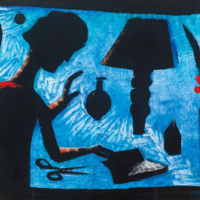58. CHARLES BLACKMAN Girl at Table c1985

Charles Blackman strode on to the international stage with the Whitechapel Gallerys 1961 exhibition, Recent Australian Painting, in which a hothouse of geniuses suddenly stepped on to the pages of history.1
This largely self-taught artist credits the six years which he spent in the United Kingdom with making him the painter that he later became, stating that I certainly would not have become the painter that I am without having had such an apprenticeship to European traditions.2 However, his engagement with the feminine began many years prior to this time and continued throughout his painting career, a career which has resulted in his works being collected by all state galleries, most regional galleries and many private collections.
While Blackman has engaged with profound emotion and fantastical imagery in order to create iconic works, such as those from his Schoolgirl and Alice in Wonderland series, he is equally at home depicting the minutiae of everyday life.
In Girl at Table the artist portrays the deceptively simple subject of a woman at a table to dramatic effect, with the positioning of the blue expanse and its undulating edges giving the illusion that she is working in front of a backdrop rather than against the flat surface of a table. The clear, intense blue of the background creates an effect akin to a light box, while the objects before her appear to float in space.
The theatricality of the setting is also of interest given that during the 1980s Blackman became involved in set design for both ballet and theatre, although the productions did not always live up to the quality of his costumes and sets. This was a period of experimentation for the artist during which he completed numerous publications and created new bodies of work, such as The Canecutter's Dream and Rainforest series. He also exhibited paintings and drawings inspired by a trip to Japan.
Blackmans use of shadow is often paradoxical in that it masks elements of the work while at the same time heightening its emotional intensity. In Girl at Table, the figure and the objects which surround her are darkened to the extent that they are almost viewed as silhouettes, although the subtle highlighting on the girls neck and arms imbues her with a sense of solidity.
The features of the central figure are shrouded in darkness, obscuring her expression, but at the same time intensifying her sense of introspection and highlighting her absorption in the task at hand. She appears to be engaged in a solitary dumb show or shadow play, performing the mundane tasks of everyday life as if they were actions of great note.
This stylised tableau is relieved by a diagonal sequence of frenetic brushstrokes which bisects the painting, tracing a path through the objects and imbuing the dramatic shadows of this work with a sense of lightness and movement. The figure remains poised with head lowered and one hand raised, seemingly apprehended mid-movement or absorbed in a moment of silent benediction. However, the more intense qualities of this painting are offset by lighter touches, such as the solitary flower lower right and also the open box upper left, which lends a fairy tale quality to the composition.
In Girl at Table, an isolated domestic moment plays out across the expansive surface of this large scale oil, demonstrating the artists mastery of the dramatic possibilities of shadow married with the expressive qualities of colour.
Footnotes
- Charles Blackman quoted in Shapcott, T., Charles Blackman, Andre Deutsch, London, 1989, p.3
- Ibid, p.4
Anne Phillips MA